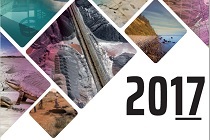 Every year, the Polish Geological Institute - National Research Institute (PGI-NRI) issues a report summarising tasks completed during the past year. The report lists tasks which PGI-NRI carried out both as a national geological survey and as a scientific organisation. In June this year, the Scientific Council of PGI-NRI accepted the Annual Report on the Institute's Activities in 2017.
Every year, the Polish Geological Institute - National Research Institute (PGI-NRI) issues a report summarising tasks completed during the past year. The report lists tasks which PGI-NRI carried out both as a national geological survey and as a scientific organisation. In June this year, the Scientific Council of PGI-NRI accepted the Annual Report on the Institute's Activities in 2017.
The report indicated significant scientific achievements of the PGI-NRI in 2017. The activities carried out were focused on the national security in terms of raw material supply, environmental protection and groundwater management. In 2017, the PGI-NRI carried out 609 projects in total, 380 of them started this year, while 229 continued from previous years; 392 projects were completed in 2017.
Most of the key projects were carried out as tasks of the Polish Geological Survey (PGS) and Polish Hydrogeological Survey (PHS). The employees of this division of PGI-NRI worked in close collaboration with the Research and Development Department of PGI-NRI; 67 projects were carried out by the PGS while 6 by the PHS.
The projects focused on regional geology and basic research supporting discoveries of raw material resources were the most promising in 2017. Some of the research was pioneering in Poland and even contributing to global research. Some of them are listed below:
- The balance of mineral resources deposits in Poland
- Support of the Chief Geologist of Poland in Raw Material Policy of the Country in 2017–2018
- Estimates of the hydrocarbon resources – phase 1
- Enhanced coalbed methane recovery in the area of Gilowice with stimulation using boreholes Gilowice 1 and Gilowice 2
Geothermal energy is becoming increasingly promising. In 2017, the PGI-NRI carried out works focused not only on medium and high temperature geothermal energy, typically used as a method of heating, but also on low-temperature geothermal energy, which requires the use of heat pumps.
The Institute conducted numerous surveys and studies leading to better understanding of the geology of Poland, both at detailed and at regional scales. As a result, numerous geological maps were produced, including the Detailed Geological Map of Poland at the scale of 1: 50 000 and the Hydrogeological Map of Poland at the scale of 1:50 000 – First Aquifer – Occurrence and Hydrodynamics.
In the field of hydrogeology and environmental protection, projects implemented in 2017 covered a very wide range of problems including prospecting and calculating groundwater resources, aquifer protection, assessing potential human impact particularly due to exploration and extraction of mineral resources, determining environmental hazards associated with various types of developments and investments, defining and mitigating risks in relation to waste management plans as well as developing analytical methodologies and implementing new research techniques. Key projects in the field of hydrogeology and environmental protection included:
- Reorganization, development and adaptation of the network of groundwater monitoring points to the requirements of the EU Water Framework Directive
- Monitoring chemical composition and assessing quality of groundwater bodies in river catchment areas in 2015–2018
- Preparing geological work proposals and hydrogeological reports on the groundwater resources in order to determine groundwater reserves and conditions for water use for individual regions and catchment areas
The Institute recorded, studied and forecasted geohazards but also carried out geological surveys to determine engineering-geology conditions. Methods of measuring deformations of the ground surface and determining geotechnical ground conditions were developed and optimised. Important projects which were carried out included:
- System of protection against landslides (phase 3) – mapping landslides and areas threatened by mass movements in the Polish Carpathians (25% of the study area) and in selected areas outside the Carpathians; forecasting landslide threats in the Carpathians
- Engineering geology database along with engineering geology maps of selected areas of the country at the scale of 1 : 10000
- Projects dedicated to detailed investigation of the geology of the Baltic seabed and the coastal zone which were the priority of the PGI-NRI in terms of the marine and coastal geology
In 2017, 20 palaeoclimatic and palaeoenvironmental studies were carried out. In order to reconstruct past climatic changes, a wide range of methods was used and included geochemical analyses of samples collected from outcrops and boreholes, classic sedimentological, stratigraphical, palaeontological and palynological analyses to study selected areas and periods in the Earth’s history as well as to reconstruct ancient environments based on modern isotopic methods.
An important achievement in the area of sharing geological information was the launch of a new spatial data website dedicated to sharing hundreds of geological, hydrogeological and geo-environmental datasets. It also allows spatial and attribute analyses of geological data. The website is innovative, organised according to categories of interests and linked to external data references.
The PGI-NRI also carried out numerous projects popularizing Earth sciences in the society and promoting the Institute by building its positive image as well as the image of the whole Polish geological community.
To conclude, 2017 was a very busy year, but the results of our work strengthened the position of the PGI-NRI as a research institution and as an organisation acting as the Polish Geological Survey and Polish Hydrogeological Survey.
Text: The editorial team of PGI-NRI
(based on the Annual Report on the Polish Geological Institute for 2017)
Translated by Tomasz Żuk














 PGI-NRI offer
PGI-NRI offer Mineral resources of Poland
Mineral resources of Poland  Oil and Gas in Poland
Oil and Gas in Poland 




 Subscribe to RSS Feed
Subscribe to RSS Feed